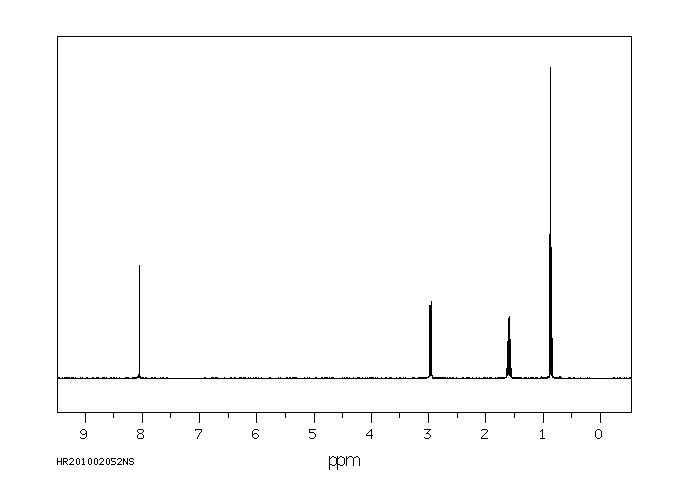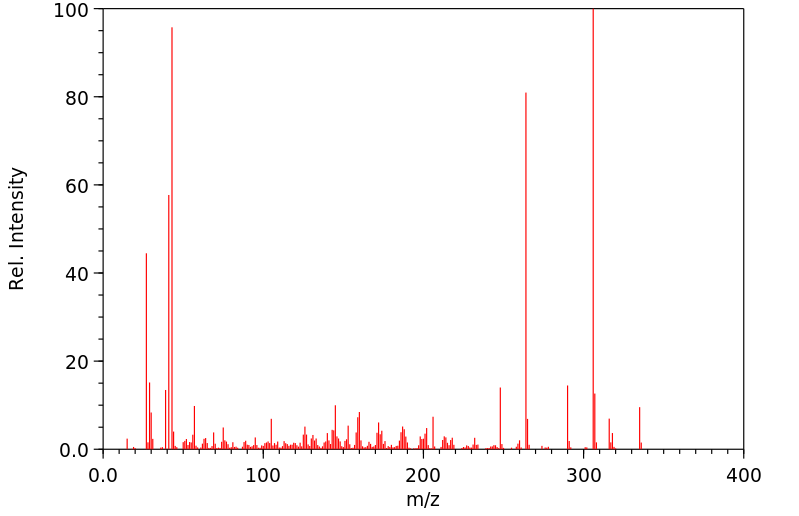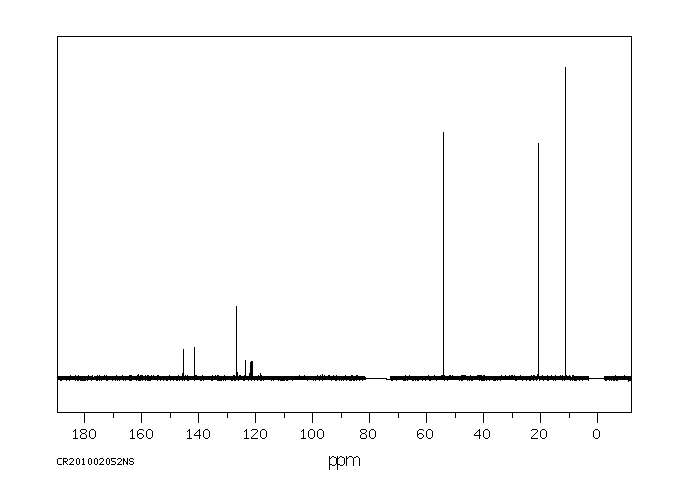氟乐灵 | 1582-09-8
-
物化性质
-
计算性质
-
ADMET
-
安全信息
-
SDS
-
制备方法与用途
-
上下游信息
-
文献信息
-
表征谱图
-
同类化合物
-
相关功能分类
-
相关结构分类
物化性质
-
熔点:48.5°C
-
沸点:139°C
-
密度:1.294
-
闪点:100 °C
-
溶解度:DMSO:≥ 100 mg/mL (298.26 mM);水:< 0.1 mg/mL(不溶)
-
LogP:5.340
-
物理描述:Trifluralin is a yellow-orange crystalline solid. Denser than water and not soluble in water. Hence sinks in water. Melting point 48.5-49°C. Used as a selective pre-emergence herbicide.
-
颜色/状态:Yellow crystals
-
气味:No appreciable odor
-
蒸汽压力:4.58X10-5 mm Hg at 25 °C
-
亨利常数:1.03e-04 atm-m3/mole
-
稳定性/保质期:
在常温常压下保持稳定,应避免与强氧化剂和强酸接触。
-
分解:202 °C
-
腐蚀性:Technical not corrosive
-
保留指数:1668;1674;1676;1668;1662.3;1685.9;1681.1;1680.1;1696.7;1662;1669.2;1684.7;1689.9;1660;1660;1685;1656.9
计算性质
-
辛醇/水分配系数(LogP):5.3
-
重原子数:23
-
可旋转键数:5
-
环数:1.0
-
sp3杂化的碳原子比例:0.538
-
拓扑面积:94.9
-
氢给体数:0
-
氢受体数:8
ADMET
安全信息
-
危险等级:9
-
危险品标志:Xi
-
安全说明:S16,S2,S24,S26,S36,S37,S60,S61
-
危险类别码:R36,R50/53,R43
-
WGK Germany:2
-
海关编码:2921430010
-
危险品运输编号:UN 2588
-
RTECS号:XU9275000
-
储存条件:请将容器密封保存,并储存在阴凉、干燥的地方。
SDS
| 第一部分:化学品名称 |
| 化学品中文名称: | 氟乐灵 |
| 化学品英文名称: | Trifiuralin |
| 中文俗名或商品名: | |
| Synonyms: | |
| CAS No.: | 1582-09-8 |
| 分子式: | C 13 H 16 F 3 N 3 O 4 |
| 分子量: | 335.29 |
| 第二部分:成分/组成信息 |
| 纯化学品 混合物 | |||
| 化学品名称:氟乐灵 | |||
|
| 第三部分:危险性概述 |
| 危险性类别: | 第6.1类 毒害品 |
| 侵入途径: | 吸入 食入 |
| 健康危害: | 目前、未见接触本品而引起中毒的病例。有报道,经常接触本品者,可引起接触性皮炎和光感性皮炎。 |
| 环境危害: | |
| 燃爆危险: | 本品可燃,有毒。 |
| 第四部分:急救措施 |
| 皮肤接触: | 脱去污染的衣着,用流动清水冲洗。就医。 |
| 眼睛接触: | 立即翻开上下眼睑,用流动清水或生理盐水冲洗。就医。 |
| 吸入: | 脱离现场至空气新鲜处。对症治疗。 |
| 食入: | 误服者用水漱口,对症治疗。 |
| 第五部分:消防措施 |
| 危险特性: | 遇明火、高热可燃。受热分解,放出有毒的氮氧化物和氟化物烟气。 |
| 有害燃烧产物: | 一氧化碳、二氧化碳、氮氧化物、氟化物。 |
| 灭火方法及灭火剂: | 尽可能将容器从火场移至空旷处。雾状水、二氧化碳、泡沫、干粉、砂土。 |
| 消防员的个体防护: | |
| 禁止使用的灭火剂: | |
| 闪点(℃): | 无资料 |
| 自燃温度(℃): | 引燃温度(℃):无资料 |
| 爆炸下限[%(V/V)]: | 无资料 |
| 爆炸上限[%(V/V)]: | 无资料 |
| 最小点火能(mJ): | |
| 爆燃点: | |
| 爆速: | |
| 最大燃爆压力(MPa): | |
| 建规火险分级: |
| 第六部分:泄漏应急处理 |
| 应急处理: | 小心扫起,在专用废弃场所深层掩埋。如大量泄漏,收集回收或无害处理后废弃。 |
| 第七部分:操作处置与储存 |
| 操作注意事项: | 密闭操作,全面通风。操作人员必须经过专门培训,严格遵守操作规程。建议操作人员佩戴自吸过滤式防尘口罩,戴化学安全防护眼镜,穿透气型防毒服,戴防化学品手套。远离火种、热源,工作场所严禁吸烟。使用防爆型的通风系统和设备。避免产生粉尘。避免与氧化剂、酸类接触。搬运时要轻装轻卸,防止包装及容器损坏。配备相应品种和数量的消防器材及泄漏应急处理设备。倒空的容器可能残留有害物。 |
| 储存注意事项: | 储存于阴凉、通风的库房。远离火种、热源。应与氧化剂、酸类分开存放,切忌混储。配备相应品种和数量的消防器材。储区应备有合适的材料收容泄漏物。 |
| 第八部分:接触控制/个体防护 |
| 最高容许浓度: | 中 国 MAC:未制订标准前苏联 MAC:未制订标准美国TLV—TWA:未制订标准 |
| 监测方法: | |
| 工程控制: | 生产过程密闭,全面通风。 |
| 呼吸系统防护: | 生产操作或农业使用时,建议佩戴防毒口罩。 |
| 眼睛防护: | 可采用安全面罩。 |
| 身体防护: | 穿工作服。 |
| 手防护: | 必要时戴防护手套。 |
| 其他防护: | 工作现场禁止吸烟、进食和饮水。工作后,彻底清洗。工作服不要带到非作业场所。 |
| 第九部分:理化特性 |
| 外观与性状: | 原药(纯度98%)为橙黄色结晶,具有芳香味。 |
| pH: | |
| 熔点(℃): | 48.5-49 |
| 沸点(℃): | 139-140(0.56kPa) |
| 相对密度(水=1): | |
| 相对蒸气密度(空气=1): | |
| 饱和蒸气压(kPa): | |
| 燃烧热(kJ/mol): | |
| 临界温度(℃): | |
| 临界压力(MPa): | |
| 辛醇/水分配系数的对数值: | |
| 闪点(℃): | 无资料 |
| 引燃温度(℃): | 引燃温度(℃):无资料 |
| 爆炸上限%(V/V): | 无资料 |
| 爆炸下限%(V/V): | 无资料 |
| 分子式: | C 13 H 16 F 3 N 3 O 4 |
| 分子量: | 335.29 |
| 蒸发速率: | |
| 粘性: | |
| 溶解性: | 不溶于水,溶于多数有机溶剂。 |
| 主要用途: | 用作农用除草剂。 |
| 第十部分:稳定性和反应活性 |
| 稳定性: | 在常温常压下 稳定 |
| 禁配物: | 强氧化剂、强酸。 |
| 避免接触的条件: | |
| 聚合危害: | 不能出现 |
| 分解产物: | 一氧化碳、二氧化碳、氮氧化物、氟化物。 |
| 第十一部分:毒理学资料 |
| 急性毒性: | 微毒类。可引起实验动物贫血及肝、肾、心肌病变。 LD50:>10000mg/kg(大鼠经口) LC50: |
| 急性中毒: | |
| 慢性中毒: | |
| 亚急性和慢性毒性: | |
| 刺激性: | |
| 致敏性: | |
| 致突变性: | |
| 致畸性: | |
| 致癌性: |
| 第十二部分:生态学资料 |
| 生态毒理毒性: | |
| 生物降解性: | |
| 非生物降解性: | |
| 生物富集或生物积累性: |
| 第十三部分:废弃处置 |
| 废弃物性质: | |
| 废弃处置方法: | 根据国家和地方有关法规的要求处置。或与厂商或制造商联系,确定处置方法。 |
| 废弃注意事项: |
| 第十四部分:运输信息 |
| |
| 危险货物编号: | 61892 |
| UN编号: | 2779 |
| 包装标志: | |
| 包装类别: | Ⅲ |
| 包装方法: | 塑料袋或二层牛皮纸袋外全开口或中开口钢桶;两层塑料袋或一层塑料袋外麻袋、塑料编织袋、乳胶布袋;塑料袋外复合塑料编织袋(聚丙烯三合一袋、聚乙烯三合一袋、聚丙烯二合一袋、聚乙烯二合一袋);塑料袋或二层牛皮纸袋外普通木箱;螺纹口玻璃瓶、塑料瓶、复合塑料瓶或铝瓶外普通木箱;塑料瓶、两层塑料袋或两层牛皮纸袋(内或外套以塑料袋)外瓦楞纸箱。 |
| 运输注意事项: | 储存于阴凉、通风仓间内。远离火种、热源。防止阳光直射。包装必须密封完整。应与氧化剂、酸类分开存放。搬运时要轻装轻卸,防止包装及容器损坏。分装和搬运作业要注意个人防护。运输前应先检查包装容器是否完整、密封,运输过程中要确保容器不泄漏、不倒塌、不坠落、不损坏。严禁与酸类、氧化剂、食品及食品添加剂混运。运输途中应防曝晒、雨淋,防高温。 |
| RETCS号: | |
| IMDG规则页码: |
| 第十五部分:法规信息 |
| 国内化学品安全管理法规: | 化学危险物品安全管理条例 (1987年2月17日国务院发布),化学危险物品安全管理条例实施细则 (化劳发[1992] 677号),工作场所安全使用化学品规定 ([1996]劳部发423号)等法规,针对化学危险品的安全使用、生产、储存、运输、装卸等方面均作了相应规定;常用危险化学品的分类及标志 (GB 13690-92)将该物质划为第6.1 类毒害品。 |
| 国际化学品安全管理法规: |
| 第十六部分:其他信息 |
| 参考文献: | 1.周国泰,化学危险品安全技术全书,化学工业出版社,1997 2.国家环保局有毒化学品管理办公室、北京化工研究院合编,化学品毒性法规环境数据手册,中国环境科学出版社.1992 3.Canadian Centre for Occupational Health and Safety,CHEMINFO Database.1998 4.Canadian Centre for Occupational Health and Safety, RTECS Database, 1989 |
| 填表时间: | 年月日 |
| 填表部门: | |
| 数据审核单位: | |
| 修改说明: | |
| 其他信息: | 4 |
| MSDS修改日期: | 年月日 |
制备方法与用途
大鼠急性经口LD50>10000 mg/kg,小鼠为5000 mg/kg,狗>2000 mg/kg。家兔急性经皮LD50>2000 mg/kg;以2000 mg/kg剂量喂养大鼠两年,未见不良影响。对鱼类毒性较大,鲤鱼LC50为4.2 mg/L(48小时),金鱼为0.59 mg/L,蓝鳃鱼为0.058 mg/L。蜜蜂致死量为24 mg/只。
化学性质本品为橙黄色结晶固体,熔点48.5~49℃(工业品为42℃),蒸气压2.65×10-2 Pa (29.5℃),1.373×10-2 Pa (25℃) ,沸点96~97℃/23.99Pa。能溶于多数有机溶剂,如二甲苯(58%)、丙酮(40%)和乙醇(7%),不溶于水。易挥发、易光解,并可被土壤胶体吸附而固定,化学性质较稳定。
用途氟乐灵是一种广谱的旱地芽前除草剂,适用于棉花、大豆、豌豆、油菜、花生、土豆、冬小麦、大麦、蓖麻、向日葵、甘蔗、蔬菜、果树等作物。主要用于防除单子叶杂草和一年生阔叶杂草,如稗草、画眉草、狗尾草、马唐、狗尾草、蟋蟀草、早熟禾、千金子、牛筋草、看麦娘、野燕麦等。也可防除小粒种子的藜、苋菜、马齿苋、繁缕、蓼等双子叶杂草。一般在播前或芽前使用,用量为5.6~11.3 g有效成分/100 m2,加水0.6~4.5 kg喷洒于土地上,8小时内耙入土中以防止光分解,杀草效果达95%。对于移栽棉花苗床,在播种覆土后使用,用48%乳油11~15 mL/100 m2,对于向日葵等作物则更具体地用量为13.6 g a.i./ha。此外,它还适用于蔬菜、果树和花卉的芽前除草。
生产方法 类别农药
毒性分级中毒
急性毒性口服 - 大鼠 LD50: 1930 毫克/公斤;小鼠 LD50: 3197 毫克/公斤。
可燃性危险特性燃烧时产生有毒氮氧化物和氟化物气体。
储运特性库房应通风、低温干燥,并与食品原料分开储运。
灭火剂干粉、泡沫、砂土。
上下游信息
-
下游产品
中文名称 英文名称 CAS号 化学式 分子量 2,6-二硝基-N-丙基-4-(三氟甲基)苯胺 α,α,α-trifluoro-2,6-dinitro-N-propyl-p-toluidine 2077-99-8 C10H10F3N3O4 293.202 3-硝基-N2-丙基-5-(三氟甲基)-1,2-苯二胺 α,α,α-trifluoro-5-nitro-N4-propyltoluene-3,4-diamine 2078-02-6 C10H12F3N3O2 263.219 4-氨基-3,5-二硝基三氟甲苯 2,6-dinitro-4-trifluoromethylaniline 445-66-9 C7H4F3N3O4 251.122 3-硝基-5-(三氟甲基)苯-1,2-二胺 3-nitro-5-trifluoromethyl-1,2-phenylenediamine 2078-01-5 C7H6F3N3O2 221.139 —— α,α,α-trifluoro-2,6-diamino-N,N-dipropyl-p-toluidine 2078-06-0 C13H20F3N3 275.317 —— 2,6-dinitro-4-trifluoromethyl-2',6'-dinitro-4'-<(trifluoromethyl)azo>benzene 69145-34-2 C14H4F6N6O8 498.212
反应信息
-
作为反应物:描述:参考文献:名称:A simple synthesis of benzimidazole N-oxides from 2-nitroaniline derivatives Scope and limitations摘要:通过在60%的1,4-二噁烷-水中用NaOH加热回流相应的N-烷基-2-硝基苯胺衍生物,合成了若干苯并咪唑N-氧化物衍生物,收率非常高。讨论了芳环和氨基上取代基对反应的影响。关键词:合成,苯并咪唑N-氧化物。DOI:10.1139/v04-083
-
作为产物:描述:参考文献:名称:Method for removing nitrosation agent(s) from a nitrated aromatic摘要:硝化剂(Nitrosation agent(s))是在用硝酸或硝化酸对芳香化合物进行硝化后作为副产物存在的,通过水处理去除,其中水以至少部分以蒸汽形式蒸馏,优选在降压下进行。通过这种方式处理的硝基化合物在进一步反应中几乎不会形成不良的亚硝胺。该过程特别适用于制造4-二正丙基氨基-3,5-二硝基苯三氟乙烷(Trifluralin),这是一种宝贵的除草剂,几乎不含亚硝胺。公开号:US04338473A1
文献信息
-
[EN] ACC INHIBITORS AND USES THEREOF<br/>[FR] INHIBITEURS DE L'ACC ET UTILISATIONS ASSOCIÉES
-
[EN] 3-[(HYDRAZONO)METHYL]-N-(TETRAZOL-5-YL)-BENZAMIDE AND 3-[(HYDRAZONO)METHYL]-N-(1,3,4-OXADIAZOL-2-YL)-BENZAMIDE DERIVATIVES AS HERBICIDES<br/>[FR] DÉRIVÉS DE 3-[(HYDRAZONO))MÉTHYL]-N-(TÉTRAZOL-5-YL)-BENZAMIDE ET DE 3-[(HYDRAZONO)MÉTHYL]-N-(1,3,4-OXADIAZOL-2-YL)-BENZAMIDE UTILISÉS EN TANT QU'HERBICIDES申请人:SYNGENTA CROP PROTECTION AG公开号:WO2021013969A1公开(公告)日:2021-01-28The present invention related to compounds of Formula (I): or an agronomically acceptable salt thereof, wherein Q, R2, R3, R4, R5 and R6 are as described herein. The invention further relates to compositions comprising said compounds, to methods of controlling weeds using said compositions, and to the use of compounds of Formula (I) as a herbicide.本发明涉及以下式(I)的化合物或其农业上可接受的盐,其中Q、R2、R3、R4、R5和R6如本文所述。该发明还涉及包含所述化合物的组合物,使用这些组合物控制杂草的方法,以及将式(I)的化合物用作除草剂的用途。
-
[EN] INSECTICIDAL TRIAZINONE DERIVATIVES<br/>[FR] DÉRIVÉS DE TRIAZINONE INSECTICIDES申请人:SYNGENTA PARTICIPATIONS AG公开号:WO2013079350A1公开(公告)日:2013-06-06Compounds of the formula (I) or (I'), wherein the substituents are as defined in claim 1, are useful as pesticides.式(I)或(I')的化合物,其中取代基如权利要求1所定义的那样,可用作杀虫剂。
-
[EN] HERBICIDALLY ACTIVE HETEROARYL-S?BSTIT?TED CYCLIC DIONES OR DERIVATIVES THEREOF<br/>[FR] DIONES CYCLIQUES SUBSTITUÉES PAR HÉTÉROARYLE À ACTIVITÉ HERBICIDE OU DÉRIVÉS DE CELLES-CI申请人:SYNGENTA LTD公开号:WO2011012862A1公开(公告)日:2011-02-03The invention relates to a compound of formula (I), which is suitable for use as a herbicide wherein G is hydrogen or an agriculturally acceptable metal, sulfonium, ammonium or latentiating group; Q is a unsubstituted or substituted C3-C8 saturated or mono-unsaturated heterocyclyl containing at least one heteroatom selected from O, N and S, or Q is heteroaryl or substituted heteroaryl; m is 1, 2 or 3; and Het is an optionally substituted monocyclic or bicyclic heteroaromatic ring; and wherein the compound is optionally an agronomically acceptable salt thereof.
-
Molecules having pesticidal utility, and intermediates, compositions, and processes, related thereto申请人:Dow AgroSciences LLC公开号:US20180279612A1公开(公告)日:2018-10-04This disclosure relates to the field of molecules having pesticidal utility against pests in Phyla Arthropoda, Mollusca, and Nematoda, processes to produce such molecules, intermediates used in such processes, pesticidal compositions containing such molecules, and processes of using such pesticidal compositions against such pests. These pesticidal compositions may be used, for example, as acaricides, insecticides, miticides, molluscicides, and nematicides. This document discloses molecules having the following formula (“Formula One”).
表征谱图
-
氢谱1HNMR
-
质谱MS
-
碳谱13CNMR
-
红外IR
-
拉曼Raman
-
峰位数据
-
峰位匹配
-
表征信息










